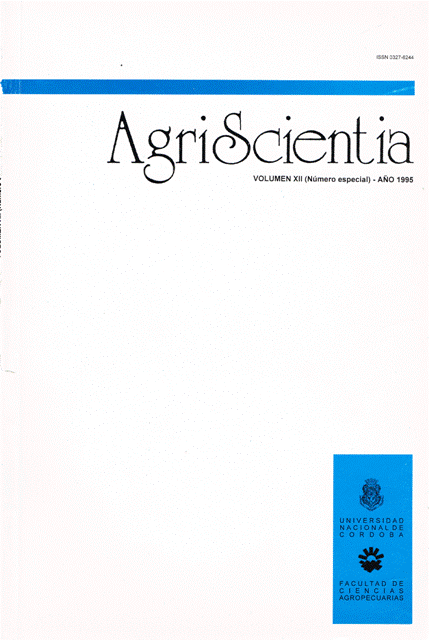Suggested agricultural systems and associated climatic risks in the province of Córdoba (Argentina).
Main Article Content
Abstract
Are classified different locations in Córdoba Province, into agronomically relevant homogeneous classes, with agroclimatic variables as relevant to dry-land agriculture. Agroclimatic attributes for 6 locations were acquired, assessing the interpretation of their meaning about agricultural systems, cropping patterns recommended, in relation to the climatic risk associated. The agroclimatic analogue technique is used in this aim. Results show a good agreement with the original methodology, though this region is not tropical. Three relevant homogeneous classes are detected, including the first, Villa Dolores, the second, Pilar, Río Cuarto and Laboulaye, and the third, Marcos Juárez and Villa María de Río Seco. The inclusion of thermic restrictions (freeze period), extending the scheme to temperate climates, modifies original method results at Laboulaye only. Delay suggested in the crop planting time must integrate both hydric and thermic risks.
Article Details

This work is licensed under a Creative Commons Attribution-ShareAlike 4.0 International License.
How to Cite
References
De la Casa, A., & Rodríguez, A. (1990). Zonificación agroclimática de la provincia de Córdoba. Primera parte: Condiciones de aridez y humedad en la región central de Argentina y su repercusión agrícola. Inédito.
De la Casa, A., & Rodríguez, A. (1991). Zonificación agroclimática de la provincia de Córdoba. Tercera parte: Sistemas agrícolas sugeridos y sus riesgos climáticos asociados en tres localidades de la provincia de Córdoba. AADA. Actas V Reunión Argentina de Agrometeorología, 177-191.
De la Casa, A. (1993). Comparación entre agroclimas cuasi homólogos de la provincia de Córdoba basada en atributos de riesgo. AGRISCIENTIA, 10, 55-61.
Frere, M., & Popov, G. F. (1986). Early agrometeorological crop yield assessment. FAO: Plant Production and Protection Paper, 73.
Kogan, F. N. (1986). Climate constraints and trends in global grain production. Agricultural and Forest Meteorology, 37, 89-107.
Moore, F., De la Casa, A., Rodríguez, A., & Sánchez, G. (1991). Zonificación agroclimática de la provincia de Córdoba. Segunda parte: Sistema de administración y procesamiento de datos. IBM-UNC. Resúmenes II Encuentro Académico Tecnológico, 36.
Ofori, F., & Stern, W. R. (1987). Cereal-legume intercropping systems. Advances in Agronomy, 41, 41-90.
Radke, J. K., & Burrows, W. C. (1970). Soybean plant response to temporary field windbreaks. Agronomy Journal, 62, 424-429.
Reddy, S. J. (1983a). Climatic classification. The semiarid tropics and its environment. A review. Pesq. Agropec. Bras., Brasília, 18(8), 823-847.
Reddy, S. J. (1983b). Agroclimatic classification of the semiarid tropics. I: A method for the computation of classificatory variables. Agricultural Meteorology, 30, 185-200.
Reddy, S. J. (1983c). Agroclimatic classification of the semiarid tropics. II: Identification of classificatory variables. Agricultural Meteorology, 30, 201-219.
Reddy, S. J. (1984a). Agroclimatic classification of the semiarid tropics. III: Characteristics of variables relevant to crop production potential. Agricultural Meteorology, 30, 269-292.
Reddy, S. J. (1984b). Agroclimatic classification of the semiarid tropics. IV: Classification of India, Senegal and Upper Volta. Agricultural Meteorology, 30, 293-325.
Reddy, S. J. (1985). Agroclimatic models and their role in agricultural planning in developing countries. Conferencia II Reunión Argentina de Agrometeorología. FCA, UNC. Córdoba, Argentina. 59 pp.
Reddy, S. J. (1988). Agroclimatic classification of the semiarid tropics. V: Methodology and classification. Inédito. 42 pp.
Reddy, S. J. (1993). Agroclimatic/agrometeorological techniques as applicable to dryland agriculture in developing countries. S. Jeevananda Reddy. 205 pp.





